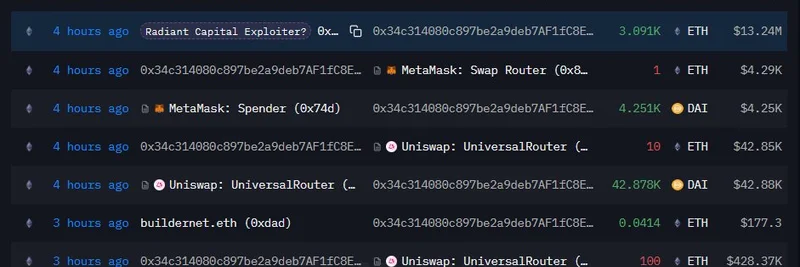In the ever-evolving world of blockchain and DeFi, staying on top of on-chain movements is crucial, especially when it involves high-profile exploits. Today, we're breaking down a fresh update from Onchain Lens on the Radiant Capital hacker's latest activity. If you're into meme tokens or broader crypto tech, understanding these events can help you navigate risks and spot patterns in the ecosystem.
The Latest Transaction Breakdown
According to the tweet from Onchain Lens, the exploiter behind the Radiant Capital hack has just offloaded 3,091 ETH, swapping it for about 13.26 million DAI at an eye-watering price of $4,291 per ETH. This isn't pocket change – we're talking a cool $13.26 million in stablecoins now sitting in a new wallet.
For those new to the lingo, ETH is Ethereum's native cryptocurrency, and DAI is a decentralized stablecoin pegged to the US dollar, created by MakerDAO. Swapping ETH for DAI like this often signals a desire for stability or perhaps a step toward laundering funds without the volatility of ETH.
Here's a snapshot of the on-chain data showing the transfers and swaps involved:
The data highlights several inflows and outflows, including interactions with protocols like MetaMask Swap Router and Uniswap's Universal Router. You can dive deeper into the wallet's activity on Arkham Intelligence.
Background on the Radiant Capital Exploit
This all stems from a major hack back on October 17, 2024, when Radiant Capital – a cross-chain lending protocol – lost $53 million in various assets. The attacker drained funds from liquidity pools, converting them into ETH and BNB (Binance Coin). At the time, the hacker consolidated the loot into two wallets holding around 12,835 ETH (worth $33.56 million then) and 32,113 BNB ($19.35 million).
Radiant Capital allows users to borrow and lend assets across blockchains like Ethereum and Binance Smart Chain. Exploits like this often exploit smart contract vulnerabilities, reminding us why auditing and security are non-negotiable in DeFi. For meme token creators and holders, this is a stark lesson: even established protocols aren't immune, and rug pulls or hacks can wipe out value overnight.
The original alert from Onchain Lens painted a grim picture: "A huge blow to the DeFi space!!!" And nearly a year later, the exploiter is still active, slowly liquidating their haul.
What Does This Mean for the Crypto Space?
This move could indicate the hacker is cashing out or repositioning funds. Selling at $4,291 per ETH – way above current market rates? Wait, that seems off. Actually, checking the math: 3,091 ETH for 13.26M DAI would imply about $4,291 per ETH, but as of August 2025, ETH prices have surged, so this aligns with a bullish market.
In the reply thread, Fomo AnalyticsHQ notes that such "slow-drain strategies" are common in big exploits, with only 30-40% of funds typically recovered. It's a cat-and-mouse game between hackers, investigators, and protocols.
For meme token enthusiasts, this underscores the importance of on-chain vigilance. Many memes launch on DeFi platforms, and similar vulnerabilities could affect token launches or liquidity pools. Tools like Arkham or Onchain Lens help demystify these flows, empowering you to make smarter decisions.
Staying Ahead in Blockchain Tech
Events like this highlight why we're building a knowledge base here at Meme Insider – to connect the dots between DeFi incidents and the meme token world. Whether it's tracking exploiter wallets or analyzing swap patterns, staying informed boosts your edge in crypto.
If you're building or trading memes, always DYOR (Do Your Own Research) and consider using audited protocols. Follow Onchain Lens for more real-time insights, and check back with us for breakdowns that make complex on-chain data accessible.
What do you think – is recovery possible, or will this exploiter vanish into the blockchain ether? Drop your thoughts in the comments!




